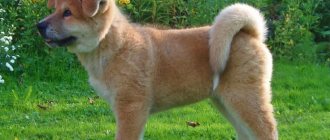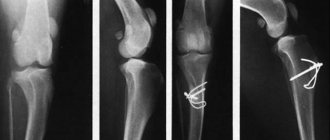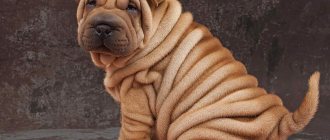- Pets
- >>
- Dog breeds
* Here is a photo of a typical representative of the Papillon dog breed . You can send us photos of your animals by email, and we will post them on the website. Don't forget to send your pet's name.
Other breed names:
Papillon
Video
* We invite you to watch a video about the Papillon . In fact, in front of you is a playlist in which you can select and watch any of 20 videos about a given dog breed by simply clicking on the button in the upper right corner of the window. In addition, the material contains quite a lot of photos. By looking at them you can find out what Papillon looks like.
In this article:
|
Rate the material!
[Total votes: 7 Average: 5]
The Papillon is an unusually attractive creature, as if straight from the pages of a fairy tale book. Such charmers can captivate anyone, it’s not for nothing that at one time they were the favorites of many royalty. Small fur balls with funny ears and lively sparkling eyes simply adore attention and affection, in which they are ready to bathe around the clock.
Papillons are restless and energetic, they are ready to accompany their owner in any adventure. Let's learn more about the origin of these babies by examining their character, habits, preferred menu and features of their content.
What to feed a Papillon puppy
When choosing a diet and diet, it is worth considering that dogs need high-calorie and quickly digestible food, enriched with vitamins, minerals and nutrients.
There is a set of general rules for feeding dwarf dogs:
- food should be warm;
- you cannot give food from your table;
- When feeding dry food, there should always be clean water in the bowl;
- raw meat must be given together with vegetables, since without them it is poorly digested;
- Vitamin and mineral supplements are added to the feed.
The menu should include: poultry, lean meat, offal, boiled egg yolk, fermented milk products.
In any case, the method of feeding should be discussed with the breeder or veterinarian.
History of the origin of Papillons
The homeland of Papillons is France. The name of these dogs is translated as “butterfly”, all because of the unusual and very attractive dog ears, which resemble the outlines of a butterfly’s wings. These dogs are also called continental toy spaniels, which were extremely popular back in the 15th century; the entire Belgian and French elite tried to acquire such a magnificent four-legged furry.
Interesting fact: In the 16th and 17th centuries, Papillons were the so-called social lions and lionesses who accompanied the high-ranking elite at various receptions and took an active part in all kinds of receptions and companies of those years. Even the French king Henry III had an extraordinary love for this dog breed.
Papillons can often be seen in group portraits of that time; they successfully posed for famous artists. Leading a rich social life, butterfly dogs fluttered at balls and various receptions. Surprisingly, some favorites became owners of entire majestic castles. Towards the end of the 19th century, Papillons were brought to America, and in the 20s of the 20th century, interest in these dogs increased among the British.
European breeders wanted to make Papillons even more attractive and irresistible, so they began to experiment by crossing them with Spitz dogs, which is why Papillons became the owners of a magnificent fur coat. In addition, as a result of this selection process, the tip of the dog's tail changed its location, moving to the upper dorsal line.
Papillons were recognized by the English Kennel Club as an independent breed in 1923. And 12 years later they were recognized by the American Cocker Spaniel Club.
Papillon - description of the breed
American breeders subdivide these dogs into Papillons and Phalenes (“mothies”). Phalens are distinguished by the structure of their ears; they have drooping ears. Europeans do not consider moth dogs to be relatives of Papillons, classifying them as a different breed. The Papillon closely resembles a Spitz or a long-haired Chihuahua, although there is no relationship between these dogs.
Papillons are very tiny, their weight varies from 2.5 to 5 kg, although it is not uncommon to find dogs weighing less than 2.5 kg (about that). The standard provides for the height of dogs at the withers, not exceeding 27 - 28 cm.
Interesting fact: The characteristic feature of Papillons is their smile. The presence of a slightly open mouth with a pink tongue in tandem with a brilliant, lively gaze makes the four-legged animals incredibly adorable, looking like plush toys.
Papillons have a head proportional to the entire canine body. Their skull cannot be called too round; it is longer than the muzzle. In smaller representatives of the breed, the feet are clearly expressed, in those that are larger, they are smoothed out. The dog's nose is small, black in color, round in shape, and slightly flattened on top. The nose itself has a flat back.
Papillons have strong, tightly spaced teeth that hide the tongue. If the tongue protrudes beyond the teeth, this is considered a defect. Dog eyes are quite large, almond-shaped, and do not differ in strong convexity. The iris is dark colored.
Naturally, the hallmark of Papillons is their butterfly ears, which have thin but strong cartilage that can hold their ears open. The tips on the ears are not sharp. A dog's ears are set high and raised when the dog is calm. The outer part of the ear is covered with long fur, like a fringe, behind which the ear edge is hidden. On the inside of the ears there is thin, curly hair, often protruding beyond the edges of the auricle.
Papillons have medium-sized necks, the scruff of which is slightly arched. The dog's dorsal part is quite flat without obvious humps and depressions. The loin is prominent, the chest is wide, and has arched ribs. The abdomen and groin area are tightened. Papillons are distinguished by smooth and graceful legs of medium length. The pads on the paws are hard, equipped with strong toes with black claws. For dogs whose feet are painted white, milky white nails are considered acceptable. Often protruding fur is visible between the toes.
The Papillon's tail is set high and has a luxurious dewlap that falls 15 cm down. When the dog moves, the tail is located along the upper dorsal part and can touch it with its tip. If the Papillon is purebred, then its tail will not curl in the shape of a donut and it will not lie completely on its back.
Description of the appearance of representatives of the Papillon breed
The main feature of the Papillon's appearance is its graceful ears, covered with long, hanging hair. Because of them, the contours of the dog resemble a butterfly. Outwardly, she looks like a plush toy: thick shiny fur, an elegant face with a charming smile, sparkling intelligent eyes. Sometimes the breed is confused with Spitz or Chihuahua, although they have nothing in common. This is a miniature spaniel. The Papillon's height is 20-28 cm, weight is from 2.5 to 5 kg.
Head
The head is proportional to the body, elongated. The muzzle is sharp, slightly pointed, the stop is pronounced. The bridge of the nose is straight, medium-sized, well pigmented. The teeth are sharp and strong. Lips are dry, teeth and tongue are not visible. The eyes are large, but not protruding, almond-shaped. They are dark in color and set low. The look is lively and attentive.
The ears are thin, large, triangular in shape, erect. They are widely spaced, the tips are rounded and directed to the sides. On the outer edge there is long, soft hair hanging down in a fringe. Because of this, the Papillon's head is contoured like a butterfly.
The phalen variety has ears set high and drooping. That's why these dogs were called so: phalène in French moth. All continental toy spaniel puppies are born with floppy ears; differences between breeds are noticeable only by 4 months.
Body type
The physique is graceful. The neck is of medium length, the scruff is pronounced. The back is straight, the lower back is convex. The chest is wide, the stomach is tucked.
The tail is set high and covered with long hair. The dog lifts it up and bends the tip. He can only lightly touch the back, but does not lie on it and does not curl into a ring.
Limbs
The limbs are thin and smooth. The elbows are pressed to the body, the joints are weakly defined. The paws are elongated, the toes are strong, and there is long hair between them. The dog's movements are smooth and graceful.
Coat and color
The coat is shiny, wavy and long. In some places it reaches a length of 15 cm. On the head and the front surface of the paws it is short and smooth. There are featherings on the ears, tail, pants and collar. There is almost no undercoat.
According to the standard, the Papillon can have any color except blue. The main thing is that white color dominates the body. Usually the spots are black or red. Three-color color possible. White markings may be present on the head.
Photos complement the description of the appearance:
Popular Papillon colors
In general, the fur of Papillons is distinguished by a certain waviness, which is given a noble silky shine, but such a fur coat cannot be called very soft. These dogs have almost no undercoat.
Short hair is present in the area:
- Heads;
- Front part of the front legs;
- Plusen.
The body has longer hair. The presence of feathering on the ears, the inside of the forelimbs, a fluffy collar and bloomers on the hips is welcome. The standard allows all kinds of colors with a predominant white tone of the body and paws.
The most common colors of this breed are:
- Tricolor (tricolor);
- White-sable (sable);
- Bicolor (white-black or white-red).
With the last type of color everything is very clear. But the white-sable color is distinguished by the presence of two colors on one hair. For example, a red hair has a black tip. Red can also vary from light (yellowish) to rich (mahogany). This color is clearly expressed in the area of the ears, where a black border (fringe) is visible against the reddish tone of the ear tissue.
Speaking about the tricolor color, it is worth noting that it is quite controversial, sometimes experts have difficulty defining it. In some dogs, the tricolor is clearly expressed, everything is immediately clear, but sometimes it is minimal or blackened on top; running your hand against the coat, you can see the tan marks only at the very base of the hair.
You can find such a color as the tricolor hound, it is characterized by a sable color in the head area, but there is a spot or several black spots on the body. The standard allows for the presence of mottling in these dogs, but many breeders consider it undesirable, although the speckles sometimes look very elegant.
Breed standard
According to the standard, representatives of the breed must have certain traits.
Many dog shows do not recognize puppies from the mating of Papillon and Phalene as the standard. In general, breed standards are strictly prescribed, and any defects in appearance are deviations from the norm.
The Butterfly dog has the following standards in official reference books:
- the animal's skull is slightly longer than the muzzle;
- the nose is smooth, with a small black nose, which is slightly flattened at the top;
- strong straight teeth completely block the animal’s tongue;
- the eyes are not protruding and low-set, almond-shaped;
- The ears are set high on the head, slightly lowered, and there is thin, long hair on the inside of the head;
- the smooth shape of the back ends with a slightly protruding lower back;
- torso, toned with a wide chest;
- limbs of medium length have slightly elongated legs;
- a high-set tail with the tip in contact with the line of the back; it should not curl into a spiral and hang straight down;
- The smooth and silky coat is long and slightly curled, with virtually no undercoat.
If the tongue seems to be hanging out over the edge of the jaw, then this is a serious defect.
At a young age, Phalene and Papillon puppies are difficult to distinguish from each other, and breeding them together is a violation of the standard. Therefore, you need to buy a puppy from trusted breeders with good ratings and reviews.
For reference! A real purebred butterfly Papillon dog costs a lot of money, so if you purchase a pet yourself via the Internet, you can run into scammers.
Dimensions and weight
Weight varies from 3 to 5 kilograms. In rare cases, adult dogs are found that are slightly lighter than the stated minimum body weight. Males, as a rule, weigh much more than females. The average height is from 24 to 28 centimeters at the withers.
Papillons are born very small and quickly gain their standard weight. Already after reaching 4 months of age, the dog can reach the dimensions of an adult.
A tricolor dog is a fairly common type in this breed.
Papillon colors
The standard is considered to be individuals with a basic background color of white fur. Other colors can be of any shade.
Most often, the dog is painted white with a sable tint on the head and tail.
Another most common shade is tricolor. In this case, the area around the muzzle is painted black and brown-red.
Character and habits of Papillons
Papillons are good-natured and sympathetic creatures. It seems that they are not in a bad mood at all. Dogs seem to wear rose-colored glasses, being tireless optimists. They find positive nuances in any situation. These four-legged pets are very inquisitive, they can be considered true explorers, because every unnoticed little thing on a walk can cause unprecedented dog interest. Papillons have a fragile and vulnerable soul, so they can fall into a depressed state from rough treatment and pressure from the owner.
Papillons are not characterized by capriciousness. They easily adapt to living in both small apartments and large country houses. Dogs are very loyal with children. Dogs do not perceive strangers as enemies and will not make noise over some nonsense; of course, only well-mannered dogs do this. If the butterfly dog is left at home all alone, then naturally it will miss its family members, but it will never cause destruction in the apartment, so there is no need to worry about damage to property.
Interesting fact: Papillons get along well with other pets, such as the same breed or cats. Experts even recommend getting your dog a friend to ward off boredom when the owner is away.
It should be added that Papillons treat large animals with suspicion and distrust, so it is better not to keep a butterfly dog and, for example, a German shepherd together. There is no need to hurt the delicate and sensitive psyche of sugar daddies (as Papillons are often called).
In general, Papillons are very gentle and, it would seem, are completely unaware of such a concept as aggressiveness. Despite all this, they are ready to protect their family, distinguished by courage and determination. These kids are ready to do a lot for the sake of their beloved owner and other equally adored household members. Surprisingly, if you anger or offend a Papillon, he can become angry and bite his ill-wisher, so these miniature dogs need training and early socialization.
Papillons are cute, mischievous creatures with a cheerful and playful disposition, always ready to have fun with their owner while engaging in active recreation. Good nature, affection and cheerfulness are the traits inherent in this breed; they give the dogs incredible charm, making them the favorites of others.
Features of character and behavior
One of the most important characteristics of the French Papillon is its constant smiling expression. The dog is very cheerful and playful, loves attention and quickly makes friends not only with other pets, but also with people. These pets are never in a bad mood, otherwise this indicates serious health problems.
Papillons are very smart and inquisitive pets. During walks, they will pay attention to every detail, even the smallest. They can rightfully be awarded the title of the best detective dogs among all breeds.
These little pets are very vulnerable, so you shouldn’t raise your voice at them or offend them. You should especially not use physical force against fragile and cheerful Papillons. The dog, despite its active, playful disposition, is quite obedient and will not make noise for no reason.
Butterfly dogs can be left alone in a house or apartment for a couple of hours without any problems; they will not cause mayhem in it.
Note! Papillons require increased attention, so it is worth placing another animal of the same size, such as a terrier, next to the dog.
Interesting facts about Papillons
By studying and analyzing interesting facts about Papillons, you can learn a lot of fascinating things about the characteristics of this sweetest breed. This will be especially useful for those who are thinking about getting such a furry pet.
Let's try to list the most unusual information about these dogs:
- Surprisingly, Papillons are related to the spaniel breed, this is explained by the fact that butterfly dogs originated from dwarf hunting quadrupeds, widespread in the territories of France and Italy. It’s not for nothing that they are officially called continental toy spaniels;
- Untrained Papillons, although small, can be aggressive;
- Papillons are among the ten smartest dogs in the world, ranking eighth according to the Stanley Coren scale;
- It is believed that these dogs have a human character, they are characterized by the presence of resentment, jealousy, joy and even smiling; all of the above emotions are immediately visible on the Papillon dog’s face;
- It is known from history that Papillons were favored by celebrities and royalty. They were pets of the Marquise de Pompadour, Marie Antoinette, and Louis XIV. Henry III spent a whole third of the state treasury on caring for dogs and purchasing these four-legged animals;
- It is interesting that all Papillons have drooping ears at birth, and they stand up between two and four months of age;
- Papillons love cats, so they can become true friends with them;
- Papillons are miniature owners of a power-hungry disposition; they will be happy to crush any member of their family who has shown weakness towards them. Dogs like to manipulate in this way;
- In the 17th century, artists often depicted Papillons in group portraits.
Character traits
Papillons are real royal dogs, combining not only elegance, grace and beauty, but also intelligence, a cheerful and cheerful disposition and good nature.
These dogs grow up to be loyal friends and wonderful companions. They are very devoted to their owner, understand him perfectly and are always ready to fulfill his every wish.
They need communication and strive to be the center of attention..
They do not like to be left alone, this can lead to destructive behavior. But, if there are other pets in the house with whom Papillons can communicate, they can endure time without their owner more easily.
Despite their compact size, representatives of this breed are good watchmen and security guards, since they are quite wary of strangers, closely monitor them and, if they feel that their owner is in danger, they will boldly come to his defense.
Continental Toy Spaniels are well suited for apartment living and adapt to life outside the city without problems . They are active and restless and need regular walks and active games.
Representatives of this breed are smart and quick-witted, they are not characterized by stubbornness and the desire to dominate.
They are easy to train and educate, because they not only quickly remember commands, but also strive to please the owner and please him.
Expert opinion
Kozhevin Semyon Kirillovich
Expert dog handler.
Continental Toy Spaniels are incredibly intelligent, as evidenced by a study that tested 79 dog breeds and Papillons came in 8th. The undoubted advantage of this breed is its balanced psyche and lack of tendency to mood swings. It should be remembered that these dogs are quite jealous and can be seriously offended by the owner if they feel that he is paying attention to someone else.
Pros and cons of Papillons
Surprisingly, even such a cute and charming dog as the Papillon has its drawbacks, however, the breed also has many advantages. Let's try to look at this dog with an unbiased eye in order to characterize all its advantages and disadvantages. Let's start with the positive features.
Pros of the Papillon breed:
- Possessing a developed intellect. The Papillon is so smart and quick-witted that it ranks first among other decorative dogs;
- The dog is easy to learn and happily trains;
- They show boundless loyalty to the owner and household members;
- In the company of members of their family, they can easily adapt to any changes, so they can safely go on a trip with their owners;
- They love to frolic with children, showing them a friendly and always loyal attitude;
- They can make friends with other pets (not too large), giving preference to cats;
- Tendency to show kindness and affection;
- Cheerful and perky disposition, optimistic character.
Disadvantages of Papillons:
- Untrained Papillons can be aggressive and bite, and their teeth are needle-sharp;
- Dogs quickly become attached to a person, then suffer greatly in his absence, so they need to show moderate attention;
- Papillons have a loud bark, which not everyone likes;
- The Papillon coat requires constant and careful care;
- Papillons do not like noise and large crowds of people;
- Dogs require constant companionship to prevent them from becoming depressed;
- The need for training and early socialization;
- They often suffer from obesity, so you need to carefully consider their diet.
Breeding Papillons
The optimal age for mating is considered to be two years of age for Papillons. It is not recommended to breed dogs earlier; this slows down their development and makes their offspring weakened. The main stage here is the selection of healthy partners who do not have hereditary diseases. If any are found, then you can begin the process, which is best started between 9 and 15 days after the female starts estrus.
For confidence and to ensure a successful result, it is recommended to carry out a couple of matings, which need to be arranged on the territory of the male dog, so that he does not get nervous and feels confident and in power. It is worth noting that both Papillons (both male and female) should be moderately well-fed, but not fat. They are dewormed and treated for fleas in advance.
If everything went well, then the female becomes pregnant, which usually goes smoothly, without any problems. At this time, you need to treat the female with care, do not pick her up, and limit excessive activity during walks. Serving sizes should be increased closer to the second half of pregnancy.
Also, special complexes of vitamins and minerals that should be given to the future dog mother will not hurt. For childbirth, you need to prepare a place with clean bedding. The day before this event, the fur on the belly and in the genital area should be trimmed.
A number of important signs indicating the onset of labor:
- The female is very worried, her breathing quickens, she may tremble and hide in corners, or follow her owner;
- In the area of the sides, pits become noticeable due to the lowering of the abdomen;
- Presence of rapid heartbeat;
- Lowering body temperature by a couple of degrees.
The presence of this condition in a dog can last from several hours to a day, then contractions begin. You need to be close to your pet, providing her with support and care. The owner sometimes has to rupture the amniotic sac himself and normalize the puppy’s breathing by removing mucus with a rubber bulb.
It is necessary to lubricate the edges of the umbilical cord with iodine if droplets of blood are visible on it. The babies that are born are placed one by one in a box with a warm heating pad. The box itself should be within the mother dog's field of vision. When the birth has come to an end, you need to change the bedding and transfer the babies to the mother.
Papillon care
In order for a butterfly dog to feel comfortable in a new home, you need to buy all the belongings necessary for its maintenance, which includes a bed with replaceable mattresses, a couple of metal or ceramic bowls, a comb for tidying up its coat, toys (it is better if they are latex ). To walk your animal you need to get a leather collar, leash and tape measure.
It is not recommended to use a harness; it can lead to eversion of bones. It is better to set up a dog’s place away from the radiator, where there are no drafts and there is an excellent view of the space, so that it would be interesting for dad to watch the household. You need to walk your dogs twice a day, for at least 30 minutes, but it can be longer, they obviously won’t mind.
As already mentioned, Papillons do not have an undercoat, so their shedding is not as bad as many people think, only during this period you need to brush your pet daily. The rest of the time, this can be done twice per week. It is worth noting that the fur is combed clean and moisturized; if this is done with dry hair, it will become very brittle. Papillons are often trimmed in certain places, this could be: the body itself, the hair between the toes, the groin and anal areas. Show-class dogs should not be groomed themselves; it is better to take them to specialists.
Papillons should be bathed as the dog gets dirty. It is better to dry the fur coat with a hairdryer, then the hairs will be straight, otherwise they will curl and be difficult to comb. If you don’t have time for regular bathing procedures, you can buy your dog a special overall for walking to protect its fur from dust and other contaminants.
Interesting fact: Papillons themselves are very neat and will not get dirty for no reason; most often, they only need to wash their paws after walks.
Dogs should have their nails trimmed; it is recommended to do this immediately after water treatments, when they (the nails) have steamed and become soft. Sometimes there is no need for such a procedure if the Papillon is walked often and for a long time, then the claws grind down on their own. Dogs are recommended to brush their teeth using a brush and a specialized paste for animals. It is useful to give your furry dogs dog chips, which counteract the formation of tartar. You also need to take care of your dog's ears and eyes. The former are wiped with a napkin soaked in an antiseptic solution (gel), and the latter – with chamomile infusion.
Basic rules of care
Before getting any pet, you should first acquire the necessary things for it: soft bedding for sleeping, ceramic or metal bowls for food and water, a special comb for wool and toys. It is better to choose items for the game from latex material. In addition, you will need a leather collar with an adjustable tape measure and a leash.
The animal must be kept warm; the place of the bed should not be exposed to cold drafts. However, you should also not keep your pet near heating appliances. Also, it is worth paying attention to the view that the dog has from its bed; it is best so that it can constantly watch its owner. Papillon dogs need to be walked every day, several times, but not for long.
Do not forget about cutting your nails, which is recommended once a month after swimming, when the claws soften in warm water.
Important! Papillon puppies at a young age often spoil shoes, sockets and other small objects, however, as they grow, they completely get rid of this habit.
Features of feeding and diet
As mentioned above, for feeding you need to buy two bowls in advance. One of them must be constantly filled with clean water at room temperature. The Papillon breed has an underdeveloped skeleton, so it is extremely important to add foods rich in calcium to the diet. Additionally, chalk, bone meal and dry milk should be mixed into the food.
The Papillon dog menu should include:
- Ready-made feed. It is best to choose super premium grain-free products.
- Protein. To a greater extent, it should consist of white lean meat, which must be boiled in water. Do not use minced meat or raw meat for feeding.
- Offal.
- Dairy products: kefir, low-fat cottage cheese, sour cream and milk.
- Fruits.
- Vegetables. Can be given both raw and boiled.
- Porridge: rice, buckwheat, millet or oatmeal.
- Fish. Raw or cooked, completely pitted.
- Egg. Protein can be given in unlimited quantities, but yolk no more than 1 piece per week.
Puppies up to 2-3 months should be fed 6 times a day; by the first year, the number of meals is gradually reduced to 2 times.
Animals need a haircut not only for decorative purposes.
Grooming
The Papillon is a dog that does not have an undercoat, so caring for its fur is not difficult. It is necessary to comb the fur 2-3 times a week. It is recommended to perform the procedure on damp fur after bathing.
To soften the butterfly dog's long fur, you need to use a special conditioner. To prevent your pet from getting dirty after daily walks, and to avoid the need for frequent “bath days,” it is recommended to buy protective overalls against dirt for your pets. In general, Papillons are neat on the street and, except for their paws, do not get dirty anywhere.
Your pet's long fur often needs to be cut. You can take him to a specialist for a haircut or carry out the procedure yourself at home. If you don’t want to get a fashionable haircut, then you should trim the long hairs on the body, between the claws, and also in the inguinal-anal area. Since Papillon wool tends to curl slightly, it is worth drying it with a hairdryer using a comb after washing. Otherwise, the fur will become tangled and difficult to comb.
Important! Be sure to wipe your eyes with a damp cotton pad twice a week. To clean your ears, soak a swab in a disinfectant solution.
Papillons are great four-legged friends with a wonderful appearance.
Papillon butterfly dogs are ideal companions for their owners. Miniature decorative pets differ from their relatives in their friendly, playful disposition, but they can be very vulnerable.
Papillon diet
The dog's menu must be balanced, then the daddy feels great, frolics, and his coat exudes shine. Low-calorie food is not suitable for dogs; it can have a negative impact on its development. A high-calorie menu is also dangerous; it can lead animals to obesity. The diet should contain food of both animal and plant origin.
So, Papillons are fed:
- Meat (beef, rabbit, veal), scalded with boiling water;
- Boiled offal;
- Porridge (rice, buckwheat, oatmeal, corn);
- Fermented milk products;
- Boiled sea fish without bones - once a week;
- Egg yolk – once a week;
- Finely chopped raw fruits and vegetables.
Naturally, all products must be fresh; it is useful to treat dogs with unrefined vegetable oil, giving half a tablespoon for several days. This should be done two or three times a year. Papillons have increased bone fragility, so they require calcium. Puppies are given milk diluted with water one to one.
It is useful to add bone meal, milk powder, seaweed powder, and chalk to the main meal. Once a week you can pamper your pet with a sugar bone. In general, small puppies (up to 3 months) are fed 6 to 8 times a day, gradually reducing the number of meals, switching to two meals a day by the age of one year. There is no need to feed your Papillon food from your table; such food will be too fatty, salty, and peppered for him.
You cannot feed dogs:
- Fried and smoked products;
- Tubular bones;
- Sausages;
- Pork;
- Various sweets;
- Baking;
- Cheese;
- Legumes and potatoes;
- River fish.
Carefully monitor the diet, do not let your dog overeat. Feed your butterflies at the same time period; there is no need to distract your pet while he is eating. Immediately after your Papillon has eaten, you should not take him outside; it is better to wait half an hour until everything in his stomach settles down.
Care and maintenance
Caring for Papillons is not difficult. Keeping a dog in an apartment is not difficult. Once a week, your pet needs to be bathed, combed and tangled. After bathing, the wool is dried with a hairdryer. Taking into account the small size of the animal, we can say that such procedures take no more than two hours a week.
Dog ears require special care. The fur on them should be taken apart and combed every day, the same can be said about the fur on the fluffy tail.
This breed has a tendency to develop tartar. Therefore, in addition to other care procedures, you should add brushing your teeth with a special paste twice a week. And for prevention, you can buy chewing toys, cleaning ropes and bones for your dog.
Diseases and health problems
In general, among all decorative breeds, Papillons are considered the strongest and healthiest, but they are not spared from the ailments typical of such dogs.
Furry pets may suffer from:
- Cataracts;
- Retinal atrophy;
- Reversible cough;
- Entropy (inversion) of the century;
- Patella (dislocation of the kneecap);
- Deafness.
Deafness is considered the scourge of this breed; it is most often congenital, and it is completely impossible to cure it. Various viral infections are very dangerous for Papillons; they can easily catch something. In order to prevent this from happening often, the dog must be vaccinated in a timely manner and undergo all routine vaccinations. If a quarantine has been declared in the area where the dog lives, it is better not to take the Papillon out of the house during this period, so as not to risk it.
Important fact: Constant care for your pet and regular hygiene procedures are the key to its healthy, happy and long life. Papillons can live from 14 to 18 years and feel vigorous even in old age.
It is necessary to constantly monitor the dog’s behavior and note any deviations that may indicate any discomfort or illness. When cleaning your eyes and ears, be extremely careful and careful, because Papillons are so sensitive and vulnerable. Proper feeding plays an important role, because excessively large portions can provoke obesity, and with it a number of other ailments.
Do not forget about preventive examinations in a veterinary clinic, which can also prevent the development of many diseases or detect them at the inception stage. In addition to routine vaccination, it is necessary to carry out regular deworming and flea treatment. By following all these simple rules and regulations and loving your pet, you can avoid many diseases, ensuring your Papillon has a cloudless existence.
Diseases and life expectancy
Papillons are characterized by good health, but genetic pathologies can still occur:
- Cataract.
- Turn of the century.
- Corneal dystrophy.
- Patella (luxation of the kneecap).
- Deafness is congenital and incurable.
There is Papillon-Lefevre syndrome, but it has nothing to do with dogs - only people suffer from it.
How long do pets live: 13-15 years. In order for the dog to live as long as possible, the owner needs:
- Do not expose your pet to stress, which for “butterflies” is prolonged loneliness, harsh punishment or screaming. Because of these things, the dog becomes depressed, which negatively affects its health.
- Sterilize or castrate an animal that is not involved in breeding work in a timely manner. Ignoring these operations shortens the life of a Papillon by 5 years.
- Organize proper nutrition, thanks to which you can avoid heart, kidney or liver diseases.
- Exercise your pet moderately physically so that he moves and breathes fresh air and does not gain harmful excess weight.
- Maintain an interval of six months between pregnancies and births of the female.











